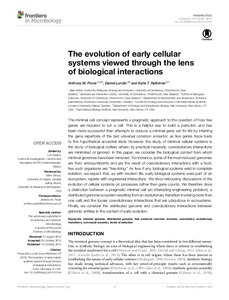The evolution of early cellular systems viewed through the lens of biological interactions.
Lundin D; Rytkönen KT.; Poole AM
https://urn.fi/URN:NBN:fi-fe2021042715178
Tiivistelmä
The minimal cell concept represents a pragmatic approach to the question of how few genes are required to run a cell. This is a helpful way to build a parts-list, and has been more successful than attempts to deduce a minimal gene set for life by inferring the gene repertoire of the last universal common ancestor, as few genes trace back to this hypothetical ancestral state. However, the study of minimal cellular systems is the study of biological outliers where, by practical necessity, coevolutionary interactions are minimized or ignored. In this paper, we consider the biological context from which minimal genomes have been removed. For instance, some of the most reduced genomes are from endosymbionts and are the result of coevolutionary interactions with a host; few such organisms are "free-living." As few, if any, biological systems exist in complete isolation, we expect that, as with modern life, early biological systems were part of an ecosystem, replete with organismal interactions. We favor refocusing discussions of the evolution of cellular systems on processes rather than gene counts. We therefore draw a distinction between a pragmatic minimal cell (an interesting engineering problem), a distributed genome (a system resulting from an evolutionary transition involving more than one cell) and the looser coevolutionary interactions that are ubiquitous in ecosystems. Finally, we consider the distributed genome and coevolutionary interactions between genomic entities in the context of early evolution.
Kokoelmat
- Rinnakkaistallenteet [19249]
